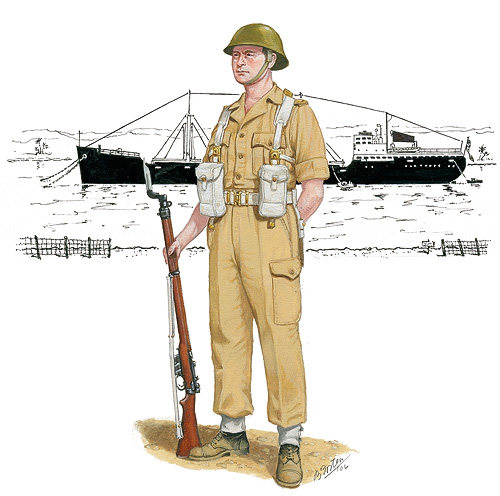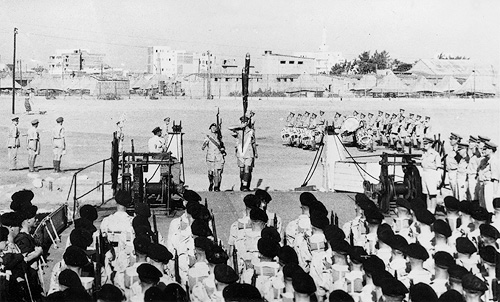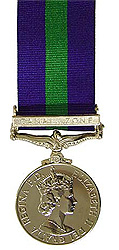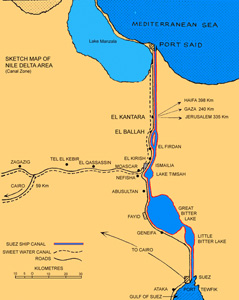1st Bn The East Surrey Regiment
The Canal Zone 1952-1955
Map of the Canal Zone.
(Click to enlarge)
The First Battalion The East Surrey Regiment arrived in the Canal Zone of Egypt in February 1953 after completing an emergency tour in Tripoli and Derna lasting some 16 months. During this time they had been held in readiness to meet an expected threat from Egypt, which did not materialize.
The Battalion, commanded by Lt Col H.B.L. Smith MC, arrived at Port Said from Tobruk on HMT ‘Devonshire’ and then moved overland to the large Ordnance Base at Tel-el Kebir (commonly referred to as T.E.K) situated on the western border of the canal zone with Egypt, about 25 miles west of the Canal. Here they rejoined 19 Infantry Brigade of 3rd Infantry Division and took over from 1 FORESTERS in ‘L’ camp, named ‘Port Louis’ camp by former occupants from Mauritius.
The news of extending the battalion’s tour to Tel el Kebir was not greeted favourably by the battalion, particularly as it had been rushed out from England as part of the first and biggest peacetime airlift of troops (45 fully equipped soldiers per Hastings aircraft) and had covered the emergency in much more attractive surroundings on the shores of the Mediterranean. However, after arriving in TEK it soon became apparent that it was not quite as bad as it had been painted and there were some compensations compared with Tripoli and Derna. Firstly,for the first time since leaving England the battalion were accommodated together. In Tripoli the battalion had been spread out over three barracks and in Derna two. Also, TEK had better facilities for sport, both in the camp and the garrison, and being alongside several major units it also gave better opportunities for competitive sport.
The camp was a well planned tented camp, spreading over a large area of flat hard sand with a few permanent single storey buildings which were used for the battalion headquarters, the main dining hall and cookhouse, the messes and the NAAFI. Companies of the battalion were accommodated in lines of marquee tents pitched on hard standing, each accommodating about 6-8 soldiers. An overhead cable brought mains electricity to each tent and piped drinking water was available in the camp, but not sewerage. This entailed the use of ‘Desert roses’ and ‘Deep trench latrines’, which were situated around the perimeter of the camp.
The Garrison of Tel el Kebir itself contained some 13,000 troops and consisted of a Base Ordnance Depot , Base Vehicle Depot, Base Workshops, Military Hospital, RMP unit with dog handlers and SIB, and with 19 Infantry Brigade and a Perimeter Defence Coy to protect it all. Brigaded with 1SURREYS were 1HLI and 1BORDER. The whole base had a 17 mile perimeter, wired and mined, with look- out posts and searchlights at intervals along the whole perimeter to protect it from thieves based in the local villages.
The operational role of the Brigade was three fold: firstly, to defend that sector of the canal zone border with Egypt and to monitor the movements of the Egyptian Army adjacent to the TEK base. Secondly, to stop any sabotage by militants operating in the area, and thirdly to stop the local Egyptians from entering the base and stealing vehicles and stores. This involved the battalion in carrying out a wide variety of guards and patrols both inside and outside the garrison - a very heavy commitment in manpower which was only met by the battalion being well up to strength with a large proportion of National Service officers and other ranks . Even so the battalion was fully stretched to meet all its commitments. These consisted of static guards on vulnerable installations serving the Garrison ,(water filtration and power generating stations); day and night patrolling around the 17 mile garrison perimeter; establishing ‘Road blocks’ along the main roads around T.E.K. and night patrols along the border with Egypt to monitor any movements by the Egyptian Army. These duties were carried out in rotation with the other two battalions of the brigade, supposedly giving each Battalion two months free for training and administration.
However, as is often the case, other outside commitments were imposed on the battalion during these so called free periods – some very attractive and others less attractive. The most attractive was providing the quarter guard for the Governor of Cyprus at his summer residence at Troodos ,Cyprus, where a composite Platoon , made up from all companies of the Battalion and under command of 2/Lt Michael Rixon, spent a very pleasant month away from the heat and dust of the desert. The fact that Lt Brian.Ray of the Regiment was ADC to the Governor at the time may have helped to gain this attractive commitment. Another enjoyable outside guard was the provision of a platoon from A Company, under command of 2/Lt Facer, – a National Service Officer - that spent two months as the divisional headquarters defence platoon at Moascar on the Canal, - one of the Zone’s more pleasant places. There were also the company ‘road blocks’ established along the old Cairo Road, which were based on a camp known as ‘Bog Camp’. The camp was in a cultivated area near the Sweet Water Canal and was surrounded by water. Dig down one foot and water appeared and a night’s sleep could only be obtained under a mosquito net. However, they were a welcome change from the perimeter patrol duties, and the searching of vehicles and their occupants and meeting the various nationalities using this important road could be an interesting experience. So too were the ‘cable cutting patrols’ which took place along the main Canal roads in order to catch the thieves who were constantly trying to steal sections of the cable for its valuable metal content. Each quarter mile was painted on the road and as soon as the cable was cut the exact point of the cut registered at the telephone company’s headquarters and was passed by radio to the patrol. Then it became a race between the thieves pulling the section of cable out of the ground with their camels and disappearing into the night and the arrival of the patrol. Unfortunately, because of the distances involved, the thieves usually won, but there were times when the patrol laid up at likely points along the road and caught the thieves red handed, usually entailing an exchange of fire before capture.
The most major outside commitment came in September 1953 when the whole battalion, less rear party, was deployed to guard one of the main ammunition depots of the of the Middle East, at Abu Sultan , near the Bitter Lake and Fayid. This commitment will always be remembered by those who took part, not so much for the guarding of the Depot, which was a arduous commitment, but for the long return march by night to T.E.K. by a direct route across the desert .The route was well navigated by the Intelligence Officer, Lt Brian Ray, but it was a hard slog and at times was a case of taking two steps forward and then slipping one step backwards in the soft sand. However, it was accomplished with great pride and was the parting shot of the Commanding Officer, Lt Col H.B.L. Smith MC., who in November 1953 handed over command of the battalion to Lt Col J.R. Armstong-MacDonnell MC., At the same time the Adjutant, Capt D.J Smith M.C., handed over to Major P.C.A. Bridgland. Subsequently the ammunition depot at Abu Sultan became a Company commitment and Companies were sent there for two weeks at a time to guard it, but they were spared the return march!

Private, 1st Bn The East Surrey Regiment, 1953 - 1954.
During the absence of the battalion at Abu Sultan a slight crisis arose in the battalion’s camp at TEK, which had been taken over by flies. In spite of gallons of DDT being sprayed almost everywhere the Egyptian flies still persisted in great numbers. However, on the return of the battalion the order went out that all ranks were to carry a fly swat on their belts (punishment for anyone caught without one) and that they would produce 25 dead flies on muster parade each morning. This meant that with a battalion of about 700 all ranks some 18,500 flies were being killed each day and it only took a few weeks before the fly problem was solved.
In spite of the heavy Guard commitments, time was found for normal conventional training within the battalion and companies carried out their annual classification on the ranges at Fayid and Quassassin . There were also desert exercises and during the 20 months in T.E.K., four major desert exercises were carried out at brigade and divisional level. In line with these desert exercises, the battalion also carried out another of its commitments of conducting desert trials on a new range of British Army vehicles. These were the Austin ¼ ton ‘Champ’, the Humber Combat 1ton, the Morris and Austin 1ton, the Bedford RL and Commer 3 ton vehicles plus a 3ton Bedford RL recovery vehicle. This entailed the MT platoon holding twice the number of vehicles normally held and most of the drivers – mainly national servicemen- having two vehicles to look after because a defect occurring on a trial vehicle meant that all similar vehicles had to be grounded until the defect had been investigated and rectified. The outcome of these trials found that only the Bedford RL 3 ton vehicle was a satisfactory vehicle for the desert - or anywhere else. The Humber combat 1 ton was eventually given armoured plating and finished up on the streets of Northern Ireland as a troop carrier and the remainder were rapidly phased out.
Except for the odd shots fired by the T.E.K. perimeter patrol at thieves making off with stores and by the anti cable cutting patrols, there were very few incidents where shots were fired , but the threat of attack was always there. There was one incident when a Stuart carrier of the anti tank platoon, commanded by Lt Nicholas, came under fire from an Egyptian Army post in a neighbouring village who thought the carrier used to tow anti tank guns (‘Mobats’ and ‘Wombats’ at that time) was a tank about to attack them. Small arms fire was returned and fortunately that ended the engagement although the incident received a lot of publicity in the Egyptian press .
The greatest threat to the Garrison came at Christmas time 1953, when it was thought that the Egyptian Army would take advantage of the festive season to make trouble . To meet this threat and to show that our guard was not lowered, 105 Battery, Royal Artillery, was attached to the battalion and their guns dug in around the perimeter of the camp. Also attached with them was an ‘Auster’ aircraft from the Air Observation flight and a strip for it to land and take off was prepared inside the camp. Drinking alcoholic drinks was also greatly restricted which meant that the festive side of Christmas 1953 became rather limited. However, there were some compensations as the ‘Auster’ aircraft was used to parachute in a dummy ‘Father Christmas’ for the childrens Christmas party held in the Sergeants Mess (his actual landing not seen by the children and the real Father Christmas surreptitiously appearing) and on ‘Boxing Day’ for flying in on the traditional ‘ Officers versus Sergeants Mess fancy dress football match’ and bombing the players with paper bags filled with flour at very low level, which caused great consternation and amusement and resulted in RSM Turner’s team leaving the pitch like ‘abominable snowmen’. However, because of all this great activity around the camp the Egyptians desisted from causing any trouble and Christmas passed off peacefully, albeit somewhat soberly.
Sport and entertainment were major factors to enhance life at T.E.K. and the battalion did well at both. Coached by C/Sgt Knight, ‘A’ Company won the T.E.K Garrison Challenge cup and under Captain John Burgess the battalion football team (“The Irons”) reached the semi Finals of the Middle East Land Forces Challenge Cup. Lt David Froud also led the Battalion Boxing Team to the Semi final round of the Canal North Boxing Championships, winning his own heavyweight fight with a knock-out, and the battalion Tug-of-war team reached the semi final of the brigade championships The battalion hockey team also excelled by winning the TEK knock out competition and although the Cricket team did not win any competitions it had a very good record of wins. At shooting, 2/lt P Dorey a National Service Officer, won the brigade ‘Best Shot’ competition. In all these sporting activities the battalion teams were greatly strengthened by the National Service members who provided some very good young players.
T.E.K. Garrison also provided quite good facilities for entertainment having a garrison theatre at which ENSA shows were staged periodically; two open air cinemas which were well run by the A.K.C and screened the current films; a swimming bath and clubs for Officers, Senior and junior ranks. Within the battalion, The Regimental Band and the Corps of Drums did a great deal to entertain. Apart from playing at military functions in the battalion and throughout the Canal Zone , the Band (firstly under Bandmaster Harriot - who very sadly died from natural causes whilst at T.E.K.- and then under Bandmaster Snowdon) played in the troops dining hall once a week during the lunch meal and also weekly in the beer garden outside the NAAFI. The Beer Garden was a self help project built by soldiers of the battalion under the direction of Lt Barry Biemans to commemorate the Queen’s Coronation in June 1953. and with its colourful constructed arches of palm trees became a very popular meeting place for soldiers in the cool of the desert evenings. Self help gardens also began to spring up around the messes and tents in the battalion area, and none more so than around the transport platoon area who had the means of conveying the soil and shrubs from the area of the Sweet water canal, and planting them around the lines in pot-like holes bored into the sand.

1 Surreys depart Egypt, 1954.
 |
| 'Canal Zone' General Service Medal. |
Early in 1954 news arrived that the British Government had reached agreement with the Egyptian Government for the withdrawal from the Canal Zone and that the battalion would be moving to Shorncliffe in Kent towards the end of the year. This started the general pack up and the preparations for the move. There were also a series of ‘farewell parties’ with the many friends of the Regiment in the Canal Zone, particularly the Royal Marines to whom the Regiment were affiliated and the Parachute Brigade who had several East Surrey Officers serving with them. First to leave, on 13th July, were the Regimental Band and a cadre party, mainly consisting of ‘B’ Company, under its commander, Major John Reed . The main party of the battalion moved to Port Said towards the end of September followed a week later by the rear party who handed the camp back to the Garrison Headquarters as there were no replacement units.
On 5th October 1954 the battalion embarked in HMT ‘Empire Ken’ and arrived at Southampton on 12th October 1954. Few were sorry to see the back of T.E.K., but it was an experience, particularly for the National Servicemen, that could be looked back on with the satisfaction and pride of having done a tedious job well under sometimes dangerous and challenging conditions and for which recognition was given, fifty years later, by the award of the ‘Canal Zone’ General Service Medal.
Related

